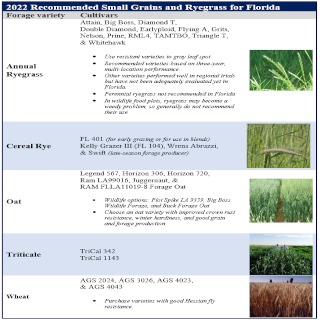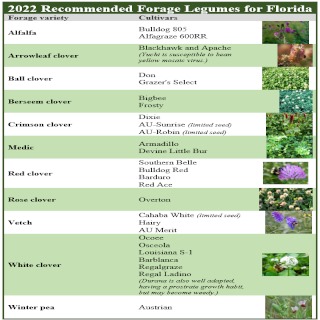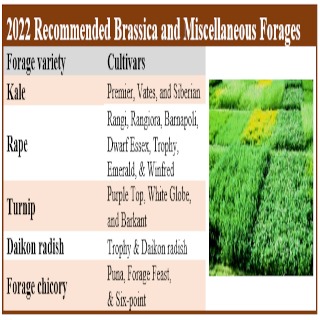- Land preparation: clean-tilled, no-tilled, or overseeded on sod?
- Soil testing: what is the pH and current soil fertility?
- Fertilization – preplant or post emergence, post-grazing fertilization?
- Seed procurement: what, where, how much and when to buy?
- Weed control: chemical, mechanical or neither?
Remember
- Planting cool-season forages on a clean-tilled seedbed results in earlier and greater total forage production compared to overseeding on grass sod. If overseeding on bahiagrass, the sod should be disked to about 30% disturbance, and using a no-till drill would be preferable to a conventional drill. For overseeding on bermudagrass, a pasture drill or no-till drill can be used alone. Excess warm-season forage should always be removed as hay or by close grazing before planting the cool-season forage.
- Unless irrigated, the success of winter forage production depends on adequate rainfall. This is especially true when overseeding.
- Cool-season legumes are more dependable on the heavier soils or on sandy soils with an underlying clay layer. However, white clover and ryegrass overseeded can also be grown successfully on flatwoods soils where the soil remains moist throughout the growing season.
- Remember to add the correct inoculant (nitrogen-fixing bacteria) to the legume seed before planting. Coated or inoculated seed is on the market, but seed coatings with bacteria have a limited shelf life and inoculated seed must be stored and handled properly to maintain the bacteria’s viability. Purchasing raw seed and inoculant separately for mixing just prior to planting is also an option, if raw seed and a viable inoculant source is available. Be aware of proper storage for pre-inoculated seeds or packaged inoculants, as excess heat may kill the bacteria.
Recommended Forage Variety Cultivars for 2022
Small Grains & Ryegrass (cool-season annual grasses)



Recommended Cool-season forage blend recipes (per acre rate)
Good Grazing/Grass and Legume Mixture for Livestock (with ryegrass)
50 lbs (or 2 Bu) oats
50 lbs (or 1 Bu) triticale or cereal rye
15 lbs ryegrass
6 lbs red clover
15 lbs crimson clover
Good Grazing/Grass and Legume Mixture for Wildlife (no ryegrass)
50 lbs (or 2 Bu) oats
50 lbs (or 1 Bu) triticale or cereal rye
6 lbs red clover
15 lbs crimson clover
Double Treat Legume Blend
For well-drained, sandy sites
10 lbs red clover
15 lbs crimson clover
Triple Treat Legume Blend
For wetter sites
12 lbs red clover
4 lbs arrowleaf clover
4 lbs white clover
Tetra Treat Legume Blend
For medium-drained to well-drained sites
15 lbs crimson clover
6 lbs red clover
4 lbs arrowleaf clover
2 lbs ball clover
Source : ufl.edu